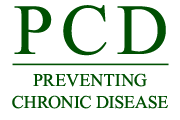PCD News Summary for September 28, 2017

Notice to News Media – PCD Release Time and Embargo Policy:
CDC’s News Media Branch releases to reporters the PCD media packet every Tuesday afternoon between 12 and 2 pm.
Embargoed until Thursday, September 28, at 12:00 PM ET
The Influence of Parental Health Literacy Status on Reach, Attendance, Retention, and Outcomes in a Family-Based Childhood Obesity Treatment Program, Virginia, 2013–2015
Regardless of their parents’ health literacy status, children enrolled in family-based Virginia childhood obesity treatment program saw benefits after completion. A three-month multicomponent family-based childhood obesity program called iChoose was conducted in the Dan River Region of Virginia — a federally designated medically underserved area. Researchers found that by incorporating design features that attended to the health literacy needs of parents, children of parents with low health literacy — similar to children of parents with high health literacy – engaged in and benefited from the program No significant difference in health literacy scores were found between parents who enrolled their child in the study and those who did not. Of 94 enrolled parents, 34 percent had low health literacy, 49 percent had an annual household income of less than $25,000, and 39 percent had a high school education or less. Health literacy status did not significantly influence improvements in the observed outcomes (child body mass index scores, parent body mass index, diet and physical activity behaviors, quality of life), with the exception of child video game and/or computer screen time. Low health literacy was associated with decreased screen time while high health literacy increased screen time.
Melissa Newton
mnewton@cdc.gov
404-718-6281
US Consumers’ Understanding of Nutrition Labels in 2013: The Importance of Health Literacy
Recent updates to nutrition labels may improve consumer understanding, dietary choices, and health, but many consumers may still have trouble interpreting the labels. A considerable proportion of U.S. consumers have difficulty understanding and using nutrition labels on food packages. These difficulties include understanding portion size, figuring out the total calories in a package of food, and estimating the effect that skipping a serving of food could have on their daily caloric intake. Researchers found approximately 24 percent of people could not determine the calorie content of a full ice-cream container, 21 percent could not estimate the number of servings equal to 60 grams of carbohydrates, 42 percent could not estimate the effect on daily calorie intake of foregoing one serving, and 41 percent could not calculate the percentage daily value of calories in a single serving. Higher scores for label understanding were associated with consuming more vegetables and less sugar-sweetened soda, although only the association with soda consumption remained significant after adjusting for demographic factors.
Melissa Newton
mnewton@cdc.gov
404-718-6281
Working to Increase Vaccination for Human Papillomavirus: A Survey of Wisconsin Stakeholders, 2015
With vaccination rate for human papillomavirus (HPV) being far below those of other vaccinations administered to adolescents in Wisconsin, local policy makers are making efforts to increase HPV vaccination uptake. Researchers conducted an online survey of 277 stakeholders in HPV vaccination activities, from April 30, 2015, through June 30, 2015. Stakeholders were public health professionals, health care providers, educators, quality improvement professionals, researchers, and advocates identified as engaged in HPV vaccination work. Of the stakeholders, 42 percent responded to the survey. Findings showed that most current HPV vaccination activities targeted three groups: adolescents and parents, clinical and health professionals, and communities and health systems. The main activities directed at these groups were providing printed educational materials, professional education, and media campaigns to raise awareness. Common barriers reported were lack of understanding about the link between HPV and cancer, requests to delay vaccination, difficulty completing the three-dose vaccine series, and reluctance to discuss sexuality.
Melissa Newton
mnewton@cdc.gov
404-718-6281
###
Note: Not all articles published in PCD represent work done at CDC. In your stories, please clarify whether a study was conducted by CDC (“a CDC study”) or by another institution (“a study published by CDC”). The opinions expressed by authors contributing to PCD do not necessarily reflect the opinions of CDC or the institutions with which the authors are affiliated. PCD requests that, when possible, you include a live link to the article in your stories.
###
U.S. DEPARTMENT OF HEALTH AND HUMAN SERVICES
CDC works 24/7 protecting America’s health, safety and security. Whether diseases start at home or abroad, are curable or preventable, chronic or acute, stem from human error or deliberate attack, CDC is committed to respond to America’s most pressing health challenges.
- Page last reviewed: September 28, 2017
- Page last updated: September 28, 2017
- Content source:



 ShareCompartir
ShareCompartir